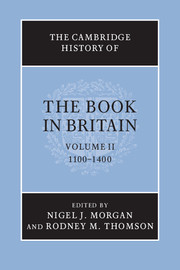Book contents
- Frontmatter
- Preface
- The roles of books
- Book production
- Readership, libraries, texts and contexts
- 9 Library catalogues and indexes
- 10 University and monastic texts
- 11 Law
- 12 Books for the liturgy and private prayer
- 13 Compilations for preaching and Lollard literature
- 14 Spiritual writings and religious instruction
- 15 Vernacular literature and its readership
- 16 History and history books
- 17 Archive books
- 18 Scientific and medical writings
- 19 Music
- 20 Illustration and ornament
- List of abbreviations
- Bibliography
- Photo credits
- General index
- Index of manuscripts
- Plates 1
- Plates 2
- References
20 - Illustration and ornament
from Readership, libraries, texts and contexts
Published online by Cambridge University Press: 28 November 2008
- Frontmatter
- Preface
- The roles of books
- Book production
- Readership, libraries, texts and contexts
- 9 Library catalogues and indexes
- 10 University and monastic texts
- 11 Law
- 12 Books for the liturgy and private prayer
- 13 Compilations for preaching and Lollard literature
- 14 Spiritual writings and religious instruction
- 15 Vernacular literature and its readership
- 16 History and history books
- 17 Archive books
- 18 Scientific and medical writings
- 19 Music
- 20 Illustration and ornament
- List of abbreviations
- Bibliography
- Photo credits
- General index
- Index of manuscripts
- Plates 1
- Plates 2
- References
Summary
The twelfth century
In England, as on the continent of Europe, the twelfth century saw the production of illuminated manuscripts on a scale not witnessed before. This reflects the overall rise in the number of books produced. There continued to be many books which were not provided with any decoration at all, and the proportion containing extensive illustration was always less than 10 per cent. Books were decorated in an English version of the Romanesque style, the first international style in Western Europe since the fall of the Roman Empire. The main patrons of illuminated books in the twelfth century were monasteries such as Bury St Edmunds, St Augustine’s Canterbury, and St Albans, and cathedral priories such as Christ Church Canterbury and St Swithun’s Winchester (the Old Minster). Secular cathedrals, such as Lincoln and Hereford, also possessed illuminated books, but it is not always clear whether they produced them themselves. But even if illuminated books were made for monastic patrons, they were not necessarily illuminated by monks: there is evidence from the twelfth century of lay professional artists working for (and sometimes in) monasteries.
Books were also imported into England from abroad, especially from Normandy. Though the Normans had lagged behind their Anglo-Saxon contemporaries in the art of manuscript illumination, their preoccupation with the decoration of initial letters was to prove the springboard for the development of the Romanesque initial as a vehicle of artistic expression in twelfth-century England. Indeed, experiments in the relationship between script, ornament and illustration were to last throughout the three centuries under review, with letters providing major sites for decoration or the opportunity to unite a visual and verbal message.
- Type
- Chapter
- Information
- The Cambridge History of the Book in Britain , pp. 474 - 487Publisher: Cambridge University PressPrint publication year: 2008



